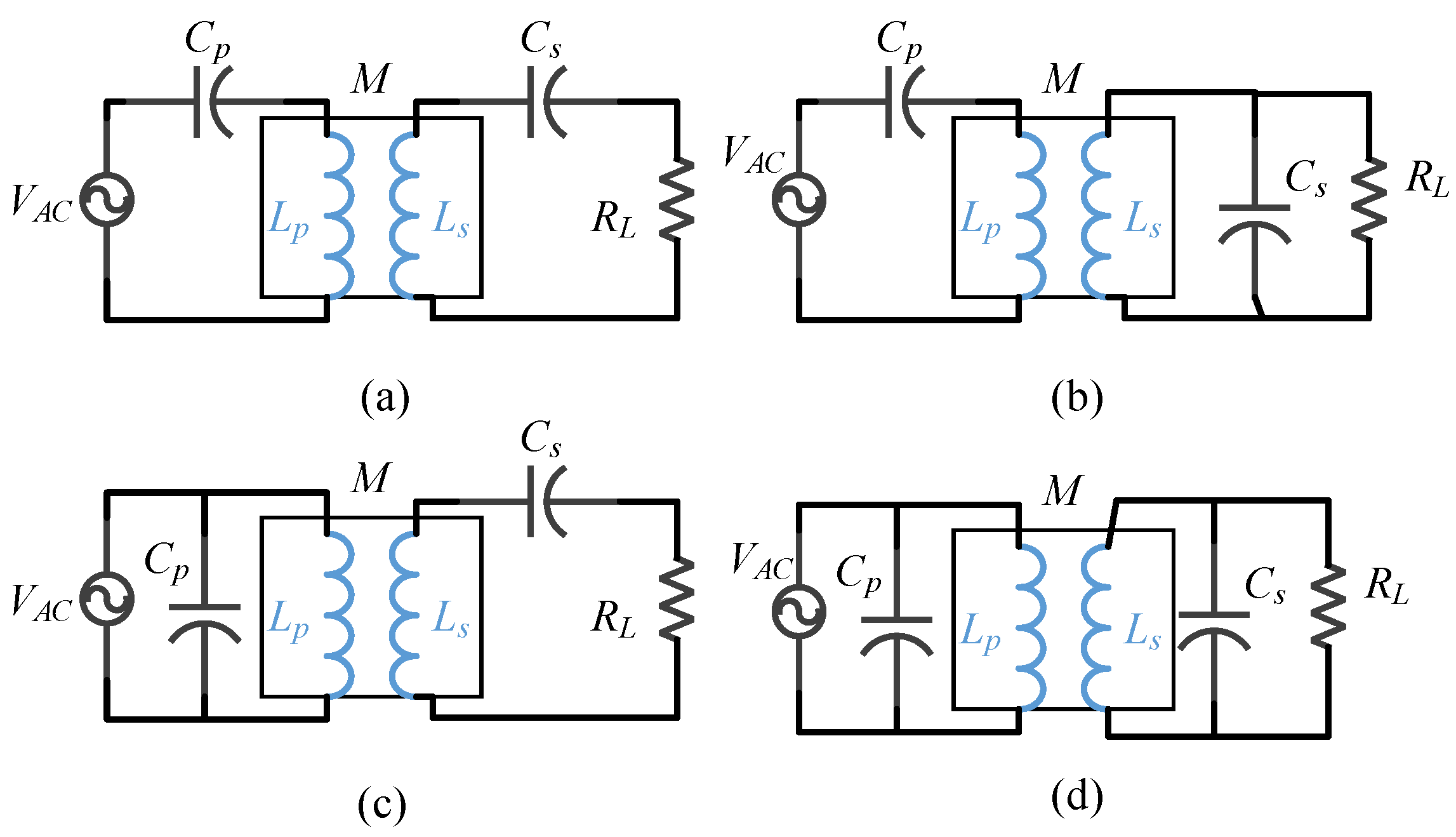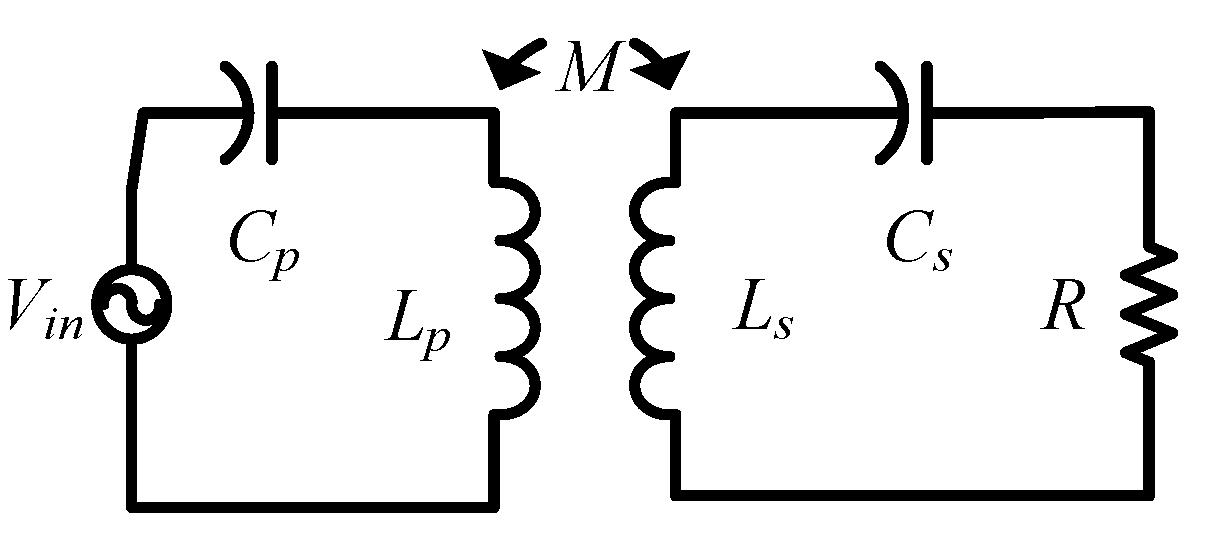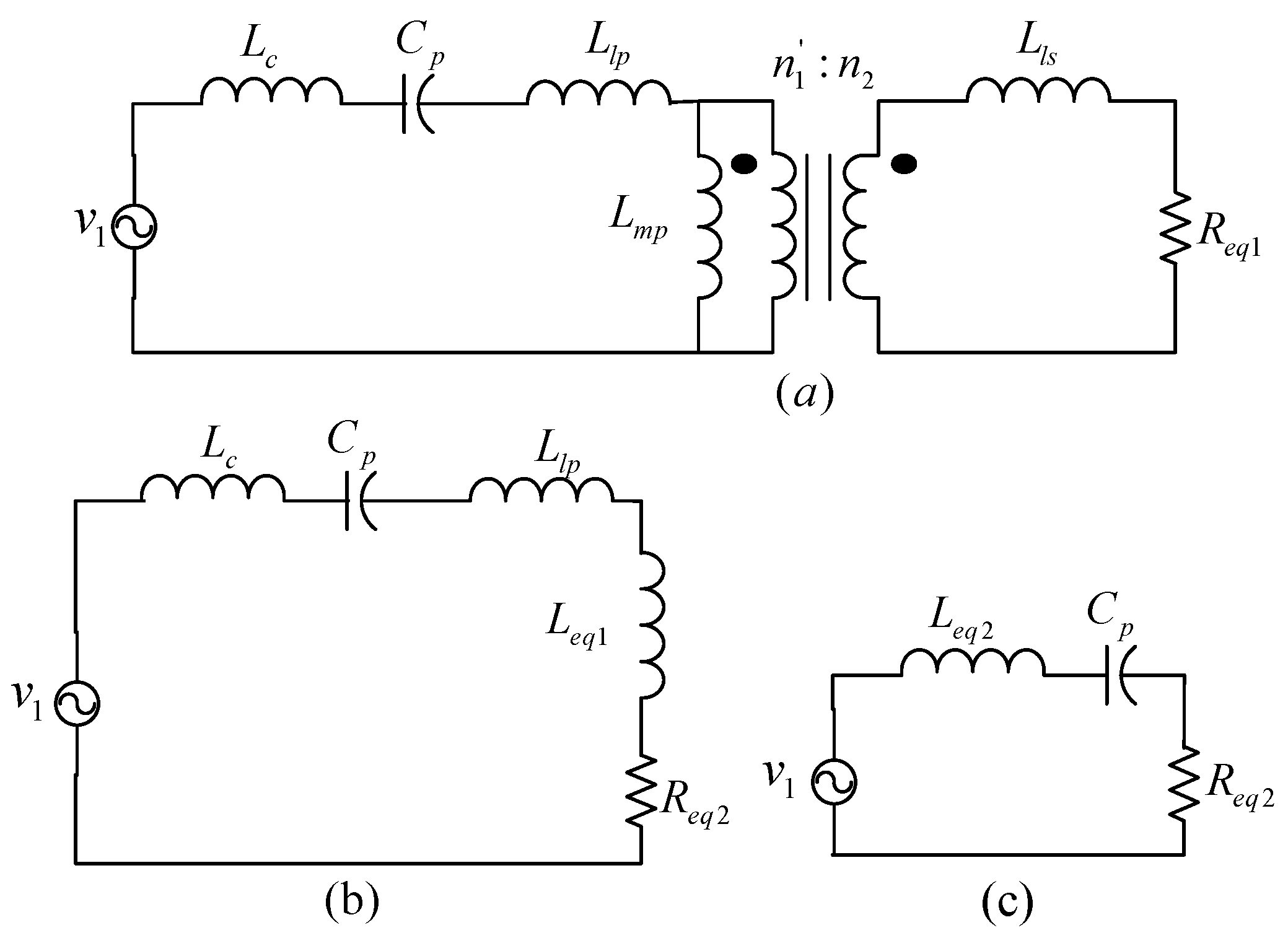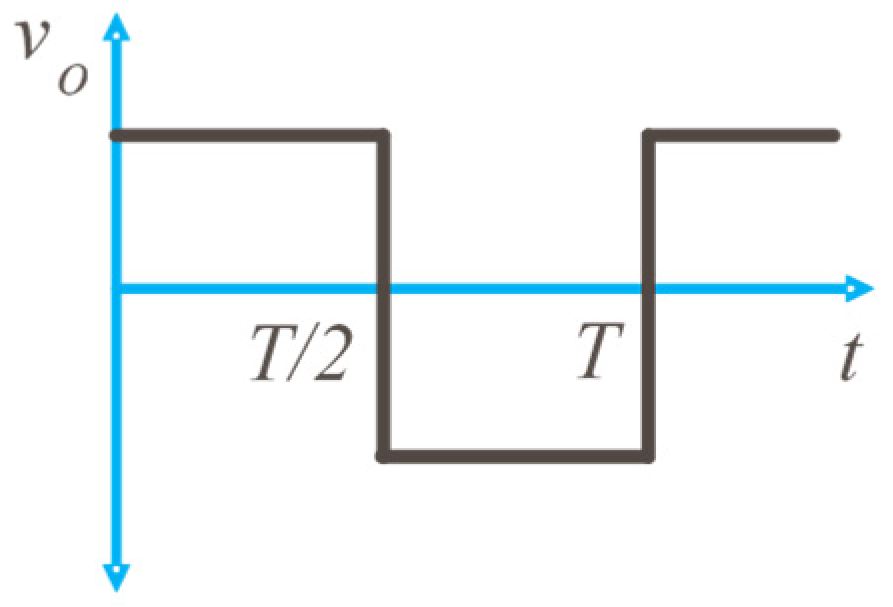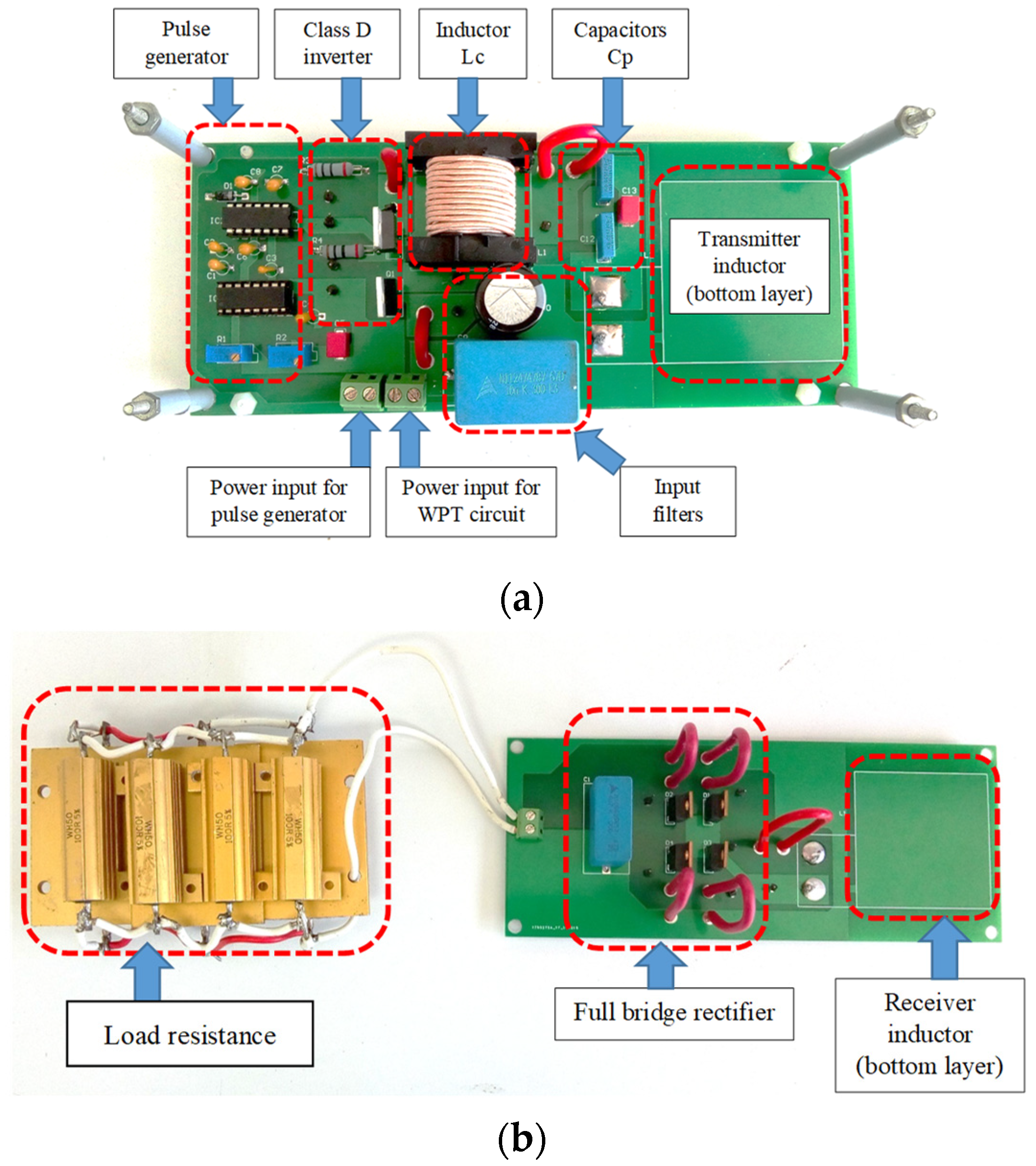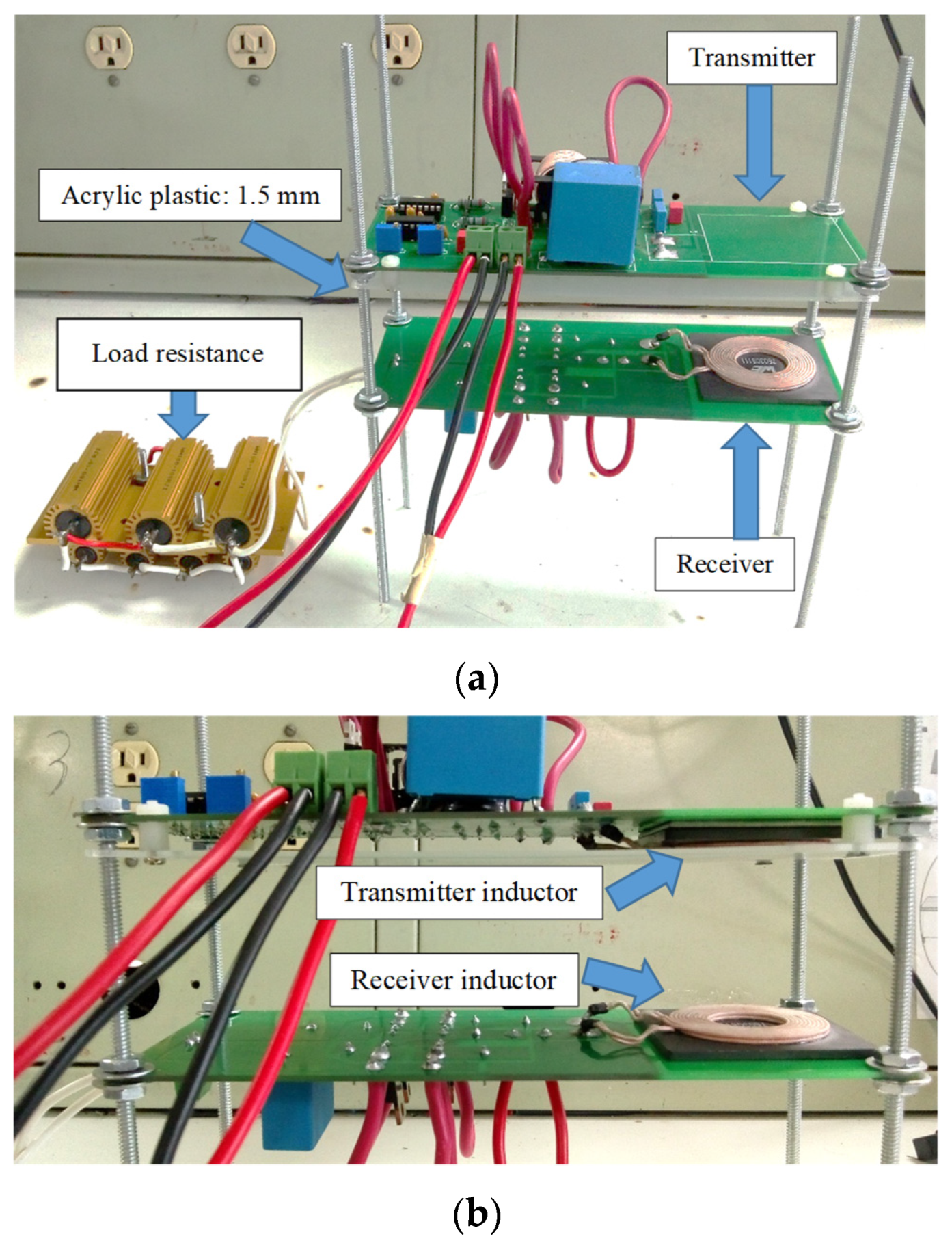1. Introduction
Nowadays, wireless power transmission (WPT) has become a trending research topic due to many applications involving no wired connections such as charging of electric vehicles, cell phones, hand tools, biomedical implants and portable electronics [
1,
2].
WPT has been used mainly in two applications—in the sending of information and electrical energy, or only for transmitting electrical energy. The second case shall be addressed in this work, with the aim of transmitting electrical power from a power supply to an electrical load, using a resonant inductive coupling [
3,
4,
5].
WPT can be classified into two categories—far-field and near-field WPT. The far-field category refers to the transmission of a large amount of energy between two positions, e.g., sending energy by electromagnetic waves. Near-field WPT refers to the distance of transfer energy within the wavelength (λ) of the transmitter antenna [
6,
7,
8]. This paper will focus on near-field WPT.
As shown in
Figure 1, inductive power transmission (IPT) circuits consist of multiple stages of energy conversion to achieve the desired operation, usually as follows: low-frequency rectifier, high-frequency (HF) inverter with a resonant tank, inductive coupling with a coupling factor
k, high-frequency rectifier, and load [
9,
10,
11]. This work is focused on the stages from the HF inverter only.
An indispensable stage in IPT circuits is the resonant tank, also known as resonant network, which is an electrical circuit designed with capacitors and inductors which is capable of storing electrical energy and oscillating when it is operating at the resonant frequency. The circuit has zero reactance during the resonance condition, allowing the maximum transfer of power from a power supply to an electrical load with high efficiency [
12,
13].
In low-power resonant IPT applications, such as wireless chargers for smartphones and portable electronic devices (less than 20 W), the literature reports efficiencies of approximately 50–70% in open-loop operation and 70–80% in closed-loop operation [
14,
15].
Usually, the IPT topologies require compensation networks to operate the circuit in resonance. The basic compensation networks are presented in
Figure 2; as can be seen, the compensation networks include a capacitor in series or parallel with the transmitter and the receiver to compensate for their inductance and to operate at resonance [
16,
17].
The full circuit needs many components to achieve optimal operation; these components cause additional losses, thus diminishing the efficiency. One solution is to consider the parasitic components (leakage inductances) and use them as part of the design to achieve high efficiency, fewer components, and better power transfer in inductive coupling [
18,
19].
Many compensation topologies have been proposed to compensate for the leakage inductances. The most used compensation topologies consist of adding one capacitor in series with each leakage inductance
Cp and
Cs (
Figure 3). Both capacitors are chosen to be in resonance with each leakage inductance [
20,
21,
22].
Table 1 shows some reported circuits with their most important operating characteristics. This table shows that a higher operating power results in better overall efficiency of the circuit. In addition,
Table 1 allows comparing the results obtained in this paper with those reported in the literature, where even though in this paper a low power of 10 W was used, an efficiency of up to 75% was achieved, which is higher than some of the circuits shown in
Table 1 with similar power levels.
The main contribution of this paper is to eliminate the compensation capacitor Cs in the receiver, compensate for the misalignment of the transmitter and the receiver with only one series capacitor in the transmitter, and add an inductor in series with this capacitor to compensate for the changes in the mutual inductance M.
The proposal simplifies the secondary circuit and reduces the complexity of the circuit, with a higher efficiency than the works reported in
Table 1. This contribution is particularly relevant in low-power applications where low size and cost are important, such as biomedical implants, portable electronics, electro mobility, and Internet of Things applications.
2. Analysis of the Circuit
The IPT circuits are usually modelled as two coupled inductors as shown in
Figure 4a, with a coupling factor
k defined as:
where
M is the mutual inductance,
L1 is the self-inductance of the primary (transmitter) and
L2 is the self-inductance of the secondary (receiver). This model is commonly employed and useful in the literature.
The main disadvantage is that the model separates the analysis of the circuit into two parts—primary and secondary. To merge both circuits in only one, model T is the usual selection [
31,
32].
Model T could be rearranged as the circuit in
Figure 4b. This circuit models the mutual inductance
M as an ideal transformer with coupling factor
k = 1 and turn relationship
n’ =
n’2/
n’1; turns
n’1 and
n’2 represent the cross section of coils
L1 and
L2 that share the same common flux φ
M and are different from the total turn number of each inductor
L1 (
n1) and
L2 (
n2). The components of this model are related to the model in
Figure 3b as shown in
Table 2.
Figure 4c shows the elements of the secondary reflected to the primary of the ideal transformer; this last model was the model used in this analysis. The proposed circuit to be analyzed in this paper is presented in
Figure 5. The HF inverter consists of a half bridge inverter with a compensation topology that is only made up of the compensation inductor
LC and the capacitor
Cp. The IPT transformer is modelled like the model in
Figure 4b, where the HF AC–DC conversion consists of a conventional full bridge rectifier.
To compensate for the variations due to the misalignment of the transmitter and receiver, as well as variations caused by the increase in the distance between the transmitter and receiver, the compensation inductor Lc will have a value greater than 90% of the inductive reactance at resonant conditions. The remaining percentage of the inductive reactance belongs to the primary dispersion inductance Llp and the equivalent inductance Leq1 obtained from the inductive coupling.
To analyze the resonant network, the resonant converter shown in
Figure 5 is simplified until an equivalent circuit is obtained in series, in which the resonance condition will be established.
Figure 6 shows the simplification process.
Figure 6a shows that the half bridge inverter is modelled as the fundamental component of the square waveform
Vin and the full bridge rectifier as a resistance
Req1 that consumes the same average power. In
Figure 6b, the leakage inductance of the receiver
Lls and the equivalent resistance
Req1 are reflected to the transmitter side, the equivalent impedance, in parallel with the primary magnetizing inductance
Lmp, is reduced into an equivalent inductance and resistance
Leq1 and
Req2, and finally, all the inductances are reduced in only one inductor
Leq2 (see
Figure 6c).
The first step of the analysis is to obtain the equivalent resistance of the full bridge rectifier
Req1. A simplified analysis is carried out in [
33], which assumes that the efficiency of the rectifier is 100%. To improve accuracy, it is possible to consider a different value for the efficiency of the rectifier
(ηr) as follows:
where
Po is the power delivered to the load (
RL) and
PR is the power delivered to the rectifier stage.
With this consideration, the equivalent resistant
Req1 is expressed as:
where
RL is the load resistance.
As indicated in the introduction, the HF rectifier is one of the stages with higher losses. So, to minimize these losses, the efficiency of the rectifier is evaluated. To evaluate this efficiency, the following simplifications will be assumed:
The voltage at the input of the full bridge rectifier (
Vo) is a square waveform in phase with the current, similar to the waveform in
Figure 7, where
Vo is the output voltage in the load resistance.
The input current in the rectifier is a sinusoidal waveform. Therefore, the losses in one diode can be evaluated with Equation (4).
where “
I” is the maximum value of the input sinusoidal current waveform of the rectifier. This current could be expressed as
I =
Vo1/Req1, where
Vo1 is the fundamental of the square voltage applied to the input of the rectifier and can be expressed as:
Vo1 = 4
Vo/π. Substituting these expressions into (4):
Substituting Equation (5) into (2), the efficiency of the rectifier could be evaluated as:
This equation is plotted in
Figure 8 assuming a forward voltage in the diodes
Vf = 0.7 V. As can be seen in this figure, for an output voltage below 12 V, the efficiency abruptly decreases, so, to maintain a high efficiency, it is recommended that the output voltage verifies
Vo > 12 V.
The rectifier efficiency graph in
Figure 8 is presented just to show and clarify that it would work with a certain voltage level due to the efficiency of the rectifier. The graph is obtained from a simplified analysis in [
33], which assumes that the efficiency of the rectifier is 100%. For this reason, the verification of this graph in the experimental tests is not necessary.
The next step is to reflect the secondary circuit of the inductive coupling to the primary circuit obtaining the circuit shown in
Figure 6b. Afterwards, to obtain the equivalent impedance formed by
Lls and
Req1 (
Zeq), the parallel circuit of both elements is evaluated:
Solving and simplifying Equation (7), the equivalent resistance
Req2 (real part of
Zeq) and equivalent inductance
Leq1 (imaginary part of
Zeq) are obtained:
As can be seen in
Figure 6c, the resulting equivalent circuit is a serial circuit composed of three inductances, a capacitor, and an equivalent resistance. Finally, the equivalent inductance
Leq2 “seen” by the square input voltage
Vin is:
The final equivalent series circuit is shown in
Figure 6c. This circuit will be in resonance when the following condition is satisfied:
where
Xcp is the reactance of
Cp and
XLeq2 is the reactance of the inductance
Leq2. Equation (13) can be used to calculate the necessary capacitance value
Cp in order to operate the circuit at resonance. The resonance condition is important so the switching losses in the MOSFET
M1 and
M2 are as small as possible. Capacitance
Cp can be calculated with the following expression:
Finally, to obtain the value of the compensation inductor, the following equation can be used:
where
a is a proposed value, and the higher the value of
a, the lower the variation of
Leq2. The worst case is when the distance
d is large, then
Llp + Leq1 ≈ 0, and the relationship
m between the worst case of
Leq2 and the nominal value of
Leq2 is:
Equation (16) was plotted as shown in
Figure 9.
According to
Figure 9, the higher the value of a, the lower the percentage of
Leq2 variations (%error), so the compensation of the distance
d variation in the transmitter and receiver misalignments will be more efficient. For example, for
a = 100, the percentage variations of
Leq2 (%error) are almost 1, which means no changes in
Leq2 for large variations of
d.
In this way, it is possible to compensate for the variation in the inductive coupling inductances with respect to the transmission distance and their misalignment. The circuit is expected to remain operating close to the resonance condition so that the maximum energy transfer can be achieved.
To evaluate the performance of the compensation inductor in relation to the resonance and efficiency of the circuit, three values of a will be proposed. The values will be a = 10, a = 20, and a = 30.
The last stage to analyze is the HF inverter, which consists of a half bridge inverter. The RMS current
IRMS of the resonant network (when it is operating at resonance) is obtained by applying Ohm’s law using the values of the input voltage
Vin and
Req2:
Another important characteristic to obtain is the value of average power
PM dissipated in each MOSFET of the inverter because this power represents the losses present in the inverter. In this analysis, it is recommended to select a desired dissipated power in the order of mW so that it does not affect the total efficiency of the circuit. Using the
IRMS and
PM values, the value of Drain-Source ON Resistance
RDS(on) that each MOSFET should have is calculated to obtain the estimated losses in the inverter:
Substituting Equation (16) into (17):
Finally, to calculate the total efficiency
ɳ value in the proposed IPT circuit, the output power
Po (present in the load resistance) and the input power
Pin (applied to the HF inverter) are used, which are substituted into the property of
P = VI. Then:
3. Design Methodology
To validate the above equations, a step-by-step design methodology for the resonance condition is proposed in this work. The considered application is to charge smartphones, so the nominal distance between the transmitter and the receiver was d = 1.5 mm.
The design methodology to be shown is when the compensating inductor has a value of 10 times the sum of Llp y Leq1 (a = 10). The proposed methodology is similar in cases where a = 20 or a = 30, and only the values of Lc, Cp and Q change, respectively, in each case.
Table 3 shows the design specifications, and a power of 10 W was considered for wireless chargers for smartphones and the output voltage of 12 V was selected according to
Figure 8. The input voltage is considered from a small photovoltaic panel.
The design obtains the properties of the inductive coupling using the following procedure:
Coupling the inductor Lp (transmitter) and Ls (receiver), correctly aligned using an acrylic plastic as the core, the thickness of the acrylic is 1.5 mm; this distance will be the transmission distance d. The inductors should not be connected to any power source or any electrical load during this measurement process.
When the inductors are coupled, an LCR tester will be used. A Hioki model 3532-50 was used in this work which is set to measure inductance at a frequency of 500 kHz; this value will be the resonance frequency at which the circuit will operate. The inductance of the primary inductor Lp (primary self-inductance) is measured by the LCR tester. Then, the inductance of the secondary inductor Ls (secondary self-inductance) is measured.
Maintaining the same conditions in the inductive coupling, the inductors Lp and Ls are connected in series, and then the measurement of the total series inductance LT is performed with the LCR tester.
Using the values obtained in the measurements, the value of the mutual inductance
M is calculated:
The value of the coupling coefficient k is calculated by substituting the values of Lp, Ls and M into Equation (1).
The primary magnetizing inductance
Lmp, primary leakage inductance
Llp and secondary leakage inductance
Lls are calculated, and the values of these inductances are obtained using the equations presented in
Table 2.
Using the method described above, the value of the inductive coupling properties shown in
Table 4 can be calculated, and then the value of the IPT circuit components can be calculated using the design methodology described in
Table 5.
Table 4 presents the characteristics of the wireless transmitter and receiver, the IPT inductors were model WE760308111 from Würth Electronics.
Table 5 presents the design methodology, where the nominal distance
d = 1.5 mm, which is the thickness of the acrylic between the transmitter and the receiver.
For the implementation of the full bridge rectifier located in the receiver circuit, the MUR840 diodes were selected. This diode model supports an average current of 8A.
The MOSFET IRFZ46N was selected for the high-frequency inverter located in the transmitter circuit. This MOSFET model has an RDS(on) of 16.5 mΩ
3.1. Implementation of Compensation Inductor Lc
The compensation inductor used for the TPI circuit was manufactured with Litz wire, which is composed of a wire number
Nw of 160 wires and each copper wire is 44 AWG. The length of the conductor
lc is 3.56 m. The compensation inductor is made up of 63 turns, using an ETD29 model that is shown in
Figure 10.
The compensation inductor designed for the TPI circuit has an air core, so the only losses that occur in the component are conduction losses in the copper of the inductor. The copper presents a parasitic resistance that will oppose the flow of electric current through the inductor. Equation (21) presents the formula to obtain the parasitic resistance of the inductor
RLc.
where
ρcu is the copper resistivity (17.2 × 10
−9 Ω∙m),
lc is the length of the conductor (3.56 m),
Nw is the wire number (160 wires) and
Ac is the wire cross sectional area (2.463 × 10
−9 m
2). Substituting these values into Equation (21):
3.2. Determination of the Properties of the Inductive Coupling with Different Distances d
In the design methodology, the value of the IPT circuit components was obtained to work correctly at distance d = 1.5 mm. As the circuit is oriented to wireless charging applications of smartphones, it is important to consider that during wireless charging there may be changes in the transmission distance with different causes; these changes directly affect the properties of the inductive coupling, modifying their value.
For that reason, before starting with the implementation of the designed circuit, the measurement and calculation of the inductive coupling properties at different distances
d must be performed using the procedure shown at the beginning of
Section 3. In the procedure, it is established that the transmission inductors during the measurements should not be connected to any power supply or any electrical load; for this reason, the measurements of the inductive coupling should be performed before the assembly of the IPT circuit on the PCB.
Ten transmission distances were selected as test points to perform measurements of the inductive coupling, with the objective of watching the changes in the coupling with respect to the distance d. This circuit being of the near-field WTP type, the inductor Ls will be moving away from Lp and the plastic acrylic (coupling core) from a distance of 1.5 mm to 4 mm; therefore, there will be 11 measured values for each property of the inductive coupling. The measured and calculated values at each transmission distance are Lp, Ls, LT, M and k.
The LCR tester was used to measure the inductances, while a digital Vernier was used for the transmission distances
d. The measured and calculated results are presented in
Table 6.
5. Conclusions
This work introduced a very simple compensation topology that consists of only one inductor useful for resonant IPT circuits operating in an open loop for low-power applications and small transmission distance applications (near-field applications), such as wireless chargers of cell phones. To compensate for changes in the transmission distance and misalignment of the transmitter and receiver, only one compensation inductor is added to the resonant tank.
A sufficiently bigger inductor is chosen to maintain the resonant tank operating near resonance for changes until the nominal transmission distance is doubled. The analysis and design methodology for the inductive coupling was presented to establish the resonance condition. The experimental results validate the proposed design methodology. In addition, they confirm the correct functioning of the circuit.
The experimental results obtained under the design conditions validate the proposed design methodology with a maximum error of 5.9% in the output power. A total efficiency of 75% was achieved at a fixed transmission distance of 1.5 mm, using acrylic as a transmission medium.
The implemented circuit operates very near to the resonance condition; comparing the theoretical design values with the experimental results, errors of 0.059% in the phase shift angle and 0.02% in the resonance frequency are obtained.
The results obtained by modifying the transmission distance demonstrate the presence of inductance variations in the inductive coupling as the transmitter inductor moves away from the receiver inductor. However, these variations could be compensated for with only one inductor used instead of more complex compensation topologies. For small variations of the transmission distances (twice or three times), this inductor compensated for the variations in the mutual inductance and self-inductances of the transmitter due to the changes in the coupling factor.
According to the obtained results, the proposed circuit is a good option as a wireless charger for cell phones in which the application transmits power over very short distances.
The circuit proposed in this work is limited to applications where the transmission distance is larger because these applications are of the far-field WPT type. In this type of application, where the distance is large, it would affect the design of the circuit presented in several ways, such as the following:
The size of the inductors Lp and Ls would increase considerably in order to realize the wireless power transmission through inductive coupling.
The input voltage Vin would need to be increased considerably to compensate for the losses in the inductive coupling, because over long distances, the inductive coupling coefficient k is usually small and the power transmission efficiency from Lp to Ls is low.
The size and the value of the compensation inductor Lc would increase because it must compensate for the misalignment of the inductors Lp and Ls in addition to trying to keep the circuit in resonance at a larger transmission distance. As the size of the inductor Lc increases, the series parasitic resistance RLc in the inductor also increases due to the length of the copper conductor, presenting a higher amount of losses in the IPT circuit.
As the value of the inductor Lc increases, as a consequence, the value of the primary capacitor Cp will decrease considerably, achieving a value that is difficult to implement because it will be valued in the order of pF or less.
The total efficiency will be low due to the losses present in the inductive coupling. In this type of application, it is recommended to combine the circuit proposed in this work with a closed-loop method that allows to adjust the resonance and bring the maximum power transfer from Lp to Ls.
The IPT circuit proposed in this work was validated and works adequately inside the limits previously described; therefore, it is recommended to be used in near-field WPT-type applications and for low-power electronic devices.

